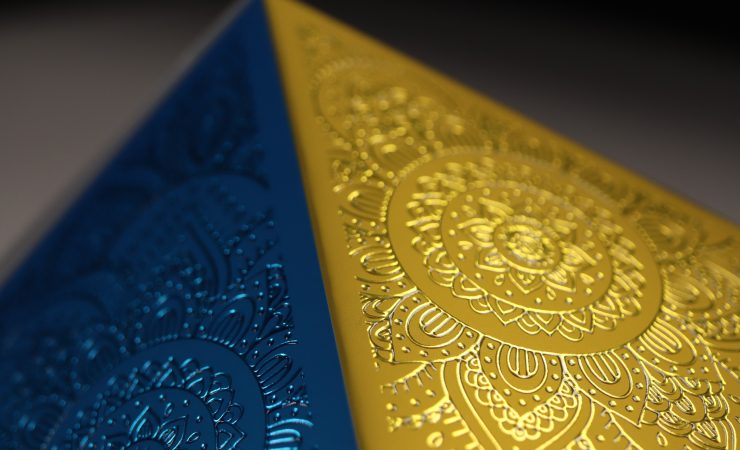Special effects printing is a way to add impact, value and margin to every sheet but there are a lot of ways it can be achieved digitally, at different points in the production process. Michael Walker shines a light on the options.
What’s now called embellishment or special effects used to be a group of purely post-press operations. These included lamination, spot or flood varnishing and foiling (hot or cold). Other eye-catching things have always had to be done in or on the press – if you wanted metallic colours you had to use a special ink or print on a metallised substrate; the same applied for fluorescent or other special colours.
Digital print has blurred those boundaries, bringing a number of ways of achieving the same or ‘close enough’ effects, combined with the flexibility and minimal set-up requirements characteristic of digital print. These also split into in-press effects and subsequently-applied effects.
Before looking at these in detail, it’s also worth noting that a sustainability argument is emerging for digital embellishment as an alternative to more conventional processes. This comes from Scodix, which makes stand-alone ‘embellishment presses’ (distributed in the UK by Friedheim) that can apply a wide range of decorative effects to printed sheets, with full digital flexibility in each.
Scodix carried out a lifecycle assessment of its digital foiling options which found that compared to conventional hot stamp foiling, its version reduces CO2e (CO2 equivalent) by 85%, fossil fuel usage by nearly 85%, and water consumption by 80% per B1 sheet. The study, carried out by EcamRicert, and Mérieux NutriSciences Companies, compared the enhancement of a single B1 sheet through to 100,000 B1 sheets using Scodix foil (175g) versus traditional foiling methods.
That’s only one of the options that Scodix offers and there’s no indication given that any of the other supported techniques offer comparable advantages. However, like any other form of digital printing, it seems likely that overall wastage of materials and energy is likely to be lower simply through the ability to only print or finish the number required.
The main argument in favour of these types of effects though is that they add impact to printed products and therefore margin to your work. Some you can only do if you bought the right press, though they could also be a factor in choosing a new one. There’s an increasing number of toner presses that offer additional colours which may include clear ‘varnish’, white, fluorescent and metallic colours, though usually only one or sometimes two at a time.
Plus-one – or more
Machines that offer a fifth colour include Xerox’s iGen line and Ricoh’s Pro C7200, also sold by Heidelberg as the Versafire EV (and about to be replaced by the Pro C7500, though we’ve not seen any specification for this yet). Kodak’s Nexpress and Nexfinity models could do this too, with options over where in the laydown sequence the fifth colour went, though both are now discontinued. Moving up to six colours brings in the popular Xerox Iridesse, and the more recent Fujifilm Revoria, while most HP Indigos can handle up to seven colours, though of course click charges go up in proportion with all extra colour presses. Xerox also offers a conversion kit for two-pass printing on its entry-level PrimeLink C9065/C9070, which potentially allows the use of up to eight colours, albeit with a complete change of toner cartridges between passes.
The exact choice of extra colours varies by manufacturer, but in addition to white – for use on coloured or transparent substrates – and clear – used to create flood or spot varnish effects – fluorescent or ‘neon’ colours are offered, particularly pink and sometimes yellow. These can replace or be mixed with their standard CMYK equivalents to expand the colour gamut for more eye-catching effects. A few offer metallic toners too, which again can be printed solid or mixed to provide novel colours and finishes.
After the event
Post-press options are more about foiling, spot varnish and various creative lamination processes, often in combination. A good entry-level choice here is foil-over-toner, a two-pass method that uses ‘real’ foil in a laminator like Vivid’s Matrix models or those from Caslon, Foliant (sold via IFS), Komfi (from Friedheim) or Autobond. Similar options also come from GMP and Intec, now part of the Plockmatic group.

An entry-level option for foil-over-toner is Vivid’s Matrix, seen here at a trade show
In these, the initial colour print is first laminated with a clear film, then printed again with the foil pattern in black toner on top of the film, before a second pass through the laminator transfers the foil to the partially melted black toner. It’s a more labour-intensive process but it works with a very wide range of foil types and doesn’t require special consumables.
Then there are the fully ‘digital’ embellishment devices that offer spot UV and/or foiling in a single operation. This category includes devices like Duplo’s B2 DuSense 8000, which is offered in various configurations providing spot UV, digital foiling or both, including a pre-treatment option for expanding the types of print that can be handled. It’s also possible to build up textured ‘3D’ effects with multiple passes, which the smaller B3 DuSense 810 also supports. An alternative is the B3+ Konica Minolta AccurioShine 3600, which uses technology from MGI, in which Konica Minolta holds a significant stake. It too can produce ‘dimensional’ effects.
At the top end of the digital embellishment market are the ranges from Konica Minolta/MGI and Scodix. These are dedicated industrial production devices that offer UV varnish and foiling, with Scodix offering a particularly wide range of foils and finished effects, while MGI’s line goes up to B1 sheet size in the form of the print-and-embellish AlphaJet that was formally launched in October 2022. Kurz is another player at the industrial end of the scale, having bought Steinemann, whose inkjet varnish and foiling systems it was already marketing as Digital Metal. These include the sheet-fed B2 DM-Smartliner for 2D flat varnishing and foiling and the DM-Maxliner for raised and textured effects.
Whether you’re just ready to dip a toe into digital embellishment and cautious with the investment, or know that you’ve got a ready market for it but need to be sure it’s good enough and fast enough to meet your customers’ needs, there should be something to suit and help your work shine.
Preparing files for embellishment
All digital embellishment processes require ‘artwork’ to control where the effects are applied. Usually this means creating additional layers in the originating applications and/or print PDFs, though some vendors offer DFE-based tools to create embellishment guides or colour substitutions from standard PDFs on-the-fly.
Andrew Bailes-Collins of Ultimate Technographics, which makes imposition, nesting and ganging software, has written a handy guide to preparing generic PDFs that should process correctly through most embellishment vendors’ DFEs and thus avoid some of the common pitfalls that require manual reworking in the prepress studio.
Called PDF Creation for Digital Embellishment, it covers the use of spot colours, layers, knock-out and overprint and choice of correct versions of PDF for hand-off. It’s available free from Ultimate Technographics’ website.





